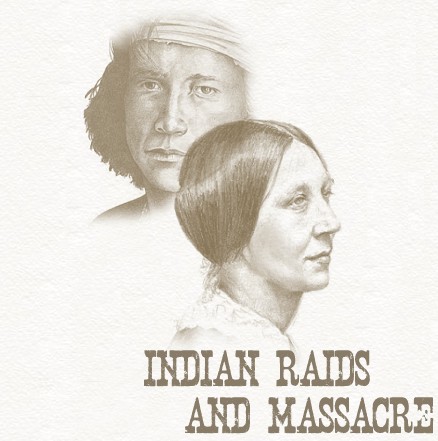

In the summer of 1864 there were stationed at the Pawnee Indian reservation, now the Town of Genoa, a company of the Seventh Iowa Cavalry. In the summer of that year Patrick Murray was engaged in putting up hay at the foot of the bluffs on Looking Glass Valley. On the evening of a certain day when Mr. Murray was at his farming and Mrs. Murray was with the haymakers cooking for them, a party of Sioux came down to the bluffs for the purpose of stealing the stock and after asking for and receiving something to eat, commenced untying the stock, and being resisted by the men in the party and by Mrs. Murray, armed with a pitchfork, immediately commenced shooting them with arrows. One of the party was Adam Smith. Murray's brother-in-law, who had settled in Columbus in 1857, coming here with his brother Michael, who was one of the original stockholders in the Town Company. He fell, shot in the body with numerous arrows, and in the bottom of the foot with a musket ball, evidently after he fell, while his foot was raised. An old man was tomahawked and scalped. Another unfortunate, Reason Grimes, was shot in the side with an arrow and when the barbed head was afterward pulled out, a portion of his liver came with it. Mrs. Murray was also shot with arrows in the limbs, and although not struck in any vital part, the wounds produced by the poisoned arrows were extremely painful and she suffered from their effects for a long time. She escaped but passed the long night in wandering up and down the Looking Glass Valley and frequently endeavored to relieve the pain of her wounds by going into the creek and bathing them. Some settlers in the vicinity, hearing the firing, came to the spot and carried off the dead and wounded. Adam Smith lived until morning, when death came to his relief. The wounded were brought to Mr. Murray's farm and Mr. Grimes, after lingering in pain for several weeks, crossed the river of death, and Mrs. Murray, after a long period of suffering, got around again, although very much broken in health.  Shortly after this there were alarming reports of a probable descent upon the settlements by hostile Indians and there was a general panic from Grand Island to the Elkhorn. The people around Grand Island flocked into that town and all the settlers around Columbus came into town and brought their stock with them. They hauled in all their cedar fence posts and built a stockade by setting one end of the post twelve inches in the ground, touching each other, which made excellent breastworks. The stockade commenced just west of the American Hotel and was continued east far enough to include Buffalo Square. There were a few openings for gates, which were always guarded at night. Thomas Lynch, Pat Gleason, the Carrigs and the whole Upper Shell Creek Settlement were there, as well as the Lusches, Reinkes, Erbs, Wetterers, Mewhus, Losekes, Edward Ahrens and his son John. All the settlers east and west in the county were here, including Herschel Needham, who lived with his wife, Christiana. One night about midnight one of the guards thought he heard Indians around and gave the alarm. The little fort became very much excited, especially Mr. Needham, who sought the partner of his joys and sorrows and thus exclaimed to her: "Now, Christiana, I expect the Indians will soon be here and I shall have all I can do to take care of myself, and you will have to skulk." The alarm proved unfounded, but spoiled the settlers' rest for that night. There was an eccentric man, named John L. Martin, who formerly lived at Buchanan but then at Grand Island, who christened that place Fort Sauerkraut, and Columbus Sockittoem. The latter was an allusion to the willingness of Columbus merchants of those days shown on all occasions to make fair profits in their mercantile transactions. After staying here two or three weeks, and the Indians failing to appear, the settlers returned to their homes. (the above article is displayed as written, including all typing & spelling errors)
Click Here To Close Window
|